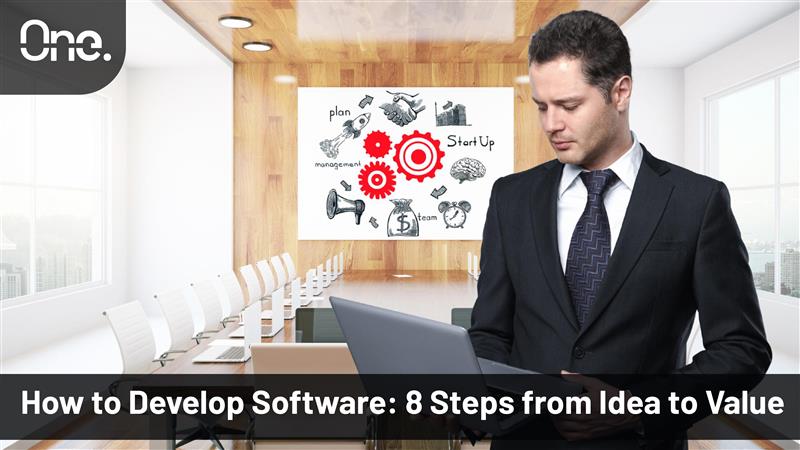In today’s digital-first economy, software is the lifeblood of innovation. Whether you’re building an internal tool to streamline operations or launching a customer-facing application, knowing how to develop software the right way, from idea to delivery, is what separates success from setbacks.
At One Technology Services, we believe software development should be more than just writing code. It’s about delivering measurable value to your business. In this guide, we’ll walk you through the 8 essential steps to turn your software idea into a functional, scalable, and strategic solution.
Step 1: Clarify the Problem and Define the Value
Every successful software product starts with a clearly defined problem. Before writing any line of code, ask:
- What problem are we solving?
- Who are we solving it for?
- How will this software create value?
Avoid vague goals like “we want a mobile app.” Instead, focus on specific outcomes such as, “we want to reduce onboarding time by 40 percent using an automated onboarding portal.”
By focusing on outcomes and value, you ensure the software aligns with business goals from the very beginning. At One Technology Services, our consulting team works closely with clients to map ideas to measurable business impact.
Step 2: Conduct Market Research and Feasibility Analysis
Before building anything, validate your idea through research:
- Are there existing solutions?
- What are the strengths and weaknesses of those products?
- What’s the market demand?
- What technologies, skills, or integrations are required?
A feasibility analysis is also critical. Is the project technically and financially viable? Understanding constraints early on allows you to make smart architectural and resourcing decisions later.
Step 3: Define Clear Requirements and User Stories
Now that your idea is validated, it’s time to document what the software must do. This is where Business Analysts, Product Owners, or experienced developers define:
- Functional requirements: what the system must do
- Non-functional requirements: security, performance, usability, scalability
- User stories: short, goal-oriented narratives describing user interactions
For example: “As a customer, I want to receive an email confirmation after placing an order.”
At One Technology Services, we prioritize clarity and stakeholder alignment during this phase to minimize downstream rework and confusion.
Step 4: Design the System Architecture and UI/UX
Designing the software is not just about aesthetics. It’s about crafting an intuitive experience and a scalable system. This stage typically includes:
- Information architecture, showing how the system’s data and workflows are structured
- Wireframes and mockups, visual representations of key screens and user flows
- System architecture, detailing how different modules, databases, APIs, and servers will interact
A strong architecture ensures your application is secure, extensible, and maintainable. Our team at One Technology Services applies proven patterns and modern design principles to ensure that the foundation of your software supports long-term success.
Step 5: Choose the Right Tech Stack
The technologies you choose today will affect how your application performs, scales, and evolves. Choosing the right stack involves:
- Understanding the application’s purpose and performance needs
- Evaluating team expertise
- Factoring in licensing, long-term maintenance, and community support
Common stacks include:
- Frontend: React, Angular, Vue.js
- Backend: Node.js, .NET, Python (Django/Flask), Java (Spring Boot)
- Databases: PostgreSQL, MongoDB, MySQL
- Infrastructure: AWS, Azure, Docker, Kubernetes
At One Technology Services, we help clients choose the right mix of technologies for speed, flexibility, and scalability, without vendor lock-in.
Step 6: Develop the Software Iteratively
Once the foundation is laid, development begins. Instead of building everything in one go, follow an iterative, Agile-based approach:
- Sprint planning, breaking work into smaller pieces (2 to 3 weeks each)
- Continuous development, where code is tested, integrated, and deployed regularly
- Frequent demos and feedback loops, ensuring alignment with stakeholders after each sprint
This approach reduces risk, ensures constant visibility, and allows faster course correction.
Our development teams at One Technology Services are trained in Agile and DevOps practices, enabling faster delivery and higher quality code across all projects.
Step 7: Test Rigorously and Continuously
Testing should not be an afterthought. It should happen throughout development. Types of testing include:
- Unit testing, to verify individual components
- Integration testing, to ensure systems interact correctly
- UI and UX testing, to validate usability and accessibility
- Load and performance testing, to confirm the system handles traffic under stress
- Security testing, to check for vulnerabilities
Automated testing, CI/CD pipelines, and manual QA are all essential to ship software with confidence. One Technology Services embeds quality assurance into every phase of the development cycle, so bugs don’t make it to production.
Step 8: Deploy, Monitor, and Optimize
Once your software is tested and approved, it’s time to deploy. But launching the product is only the beginning. Post-launch steps include:
- Deploying to production using CI/CD tools like GitHub Actions, Jenkins, or GitLab
- Monitoring application health with tools like Datadog, New Relic, or Azure Monitor
- Gathering real-world user feedback to identify UX or performance issues
- Tracking KPIs such as load time, crash rate, churn rate, or task completion
Optimization is ongoing. You should continuously refine features, fix issues, and release updates based on usage data.
At One Technology Services, we offer full post-launch support and product growth services, helping clients continuously deliver value through their software.
Final Thoughts: Delivering Real Business Value
Software development is not about building features. It is about solving real problems and driving measurable outcomes. By following these 8 steps, you move from idea to execution with clarity, speed, and purpose.
Whether you’re developing a SaaS platform, mobile app, or enterprise integration, following a structured software development process ensures you build something that lasts and works.
At One Technology Services, we partner with startups, enterprises, and digital teams to develop custom software that is aligned with business goals. From initial discovery to post-launch optimization, we provide the strategy, design, engineering, and support to help you turn ideas into impact.

